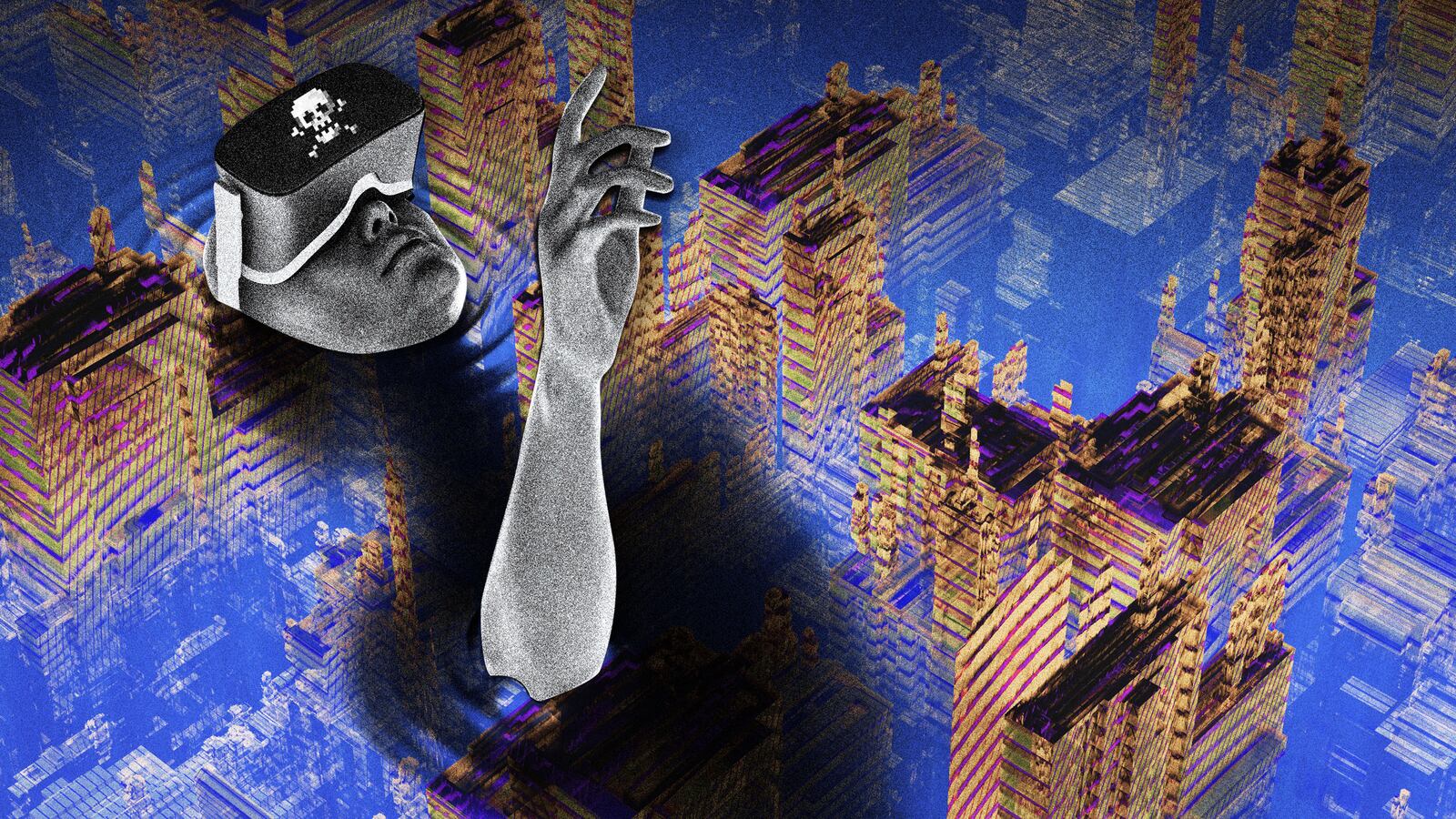Whether we like it or not, metaverse fever is rising. From flaming Travis Scott towering over players in Fortnite, to suit-clad avatars arguing spreadsheets on Teams, to Facebook swapping its face for Meta—it seems there’s been an onslaught of new virtual playgrounds brought to life every day. But for every new virtual world being born, there’s a digital graveyard of realms that have already died.
Today, “The Metaverse” is actually less definitive than it sounds. Sci-fi author Neal Stephenson originally coined the term in 1992 in his book Snow Crash, which depicted an immense cyberscape of splashy computer-generated characters, controlled by humans and connected by the internet. In Stephenson’s book there was one virtual world to rule them all. But our reality is more nebulous. David Bohnett, the creator of the GeoCities, an iconic interconnected society of websites from the mid-90s, told The Daily Beast that thinks of the Metaverse as “how you define your online presence within a virtual community or a virtual world.”
GeoCities was revolutionary because it let users create digital real-estate that was organized by physical, geographic identity. It virtually mapped the internet by interest. “I could set up a web page in Nashville because I want to talk about country music. Or I could set up a page in Area 51 because I want to talk about UFOs,” said Bohnett. “There isn’t just one metaverse, just like there isn’t one internet. There’s a fractionalization of internets and there will always be parts that are blocked, go offline, or survive in different corners of space. GeoCities is a great example of that.”
As internet speeds grew and users gained interest in sculpting their online identities, story and gameplay started to take hold, which spawned new metaverses. First there were MUDs, or multi-user dungeons. These were text-based online games, like LamdaMOO and LegendMUD, that invited players to quest, fight, and share rewards together. Then came games with crudely rendered graphical figures like The Shadow of Yserbius and Neverwinter Nights. By the late 1990s, metaverse designers started experimenting with evolving worlds, monsters, seasonal pageantries, and player vs. player arenas. But as with all things born into cyberspace, what goes online must also go offline.
There are many things that can go wrong in cyberspace and ultimately bring the downfall of a metaverse. This mostly has to do with the monetary upkeep of adding patches, stories, and new characters—elements that make the world feel like it's fully alive. But once the cord has been decidedly cut, how does that end play out in the theater of the game?
One famous event was detailed by Richard Garriot, President of the Explorers Club and creator of Ultima Online, in his book Explore/Create. In 1997, Ultima Online, a fantasy roleplaying world where players could kill monsters or fight one another, was one of the most successful massive-multiplayer games on the market. But as the project moved from its Beta phase to open-market, Garriot encountered a problem. He would need to reset the server and wipe all of the player data. This meant everyone in the game would lose their hard-earned homes, weapons, and experience levels. It was the end of the beginning.
To commemorate the death of the old world and the birth of the new one, Garriott had planned to travel with his immortal avatar, Lord British, from town to town giving speeches, thanking everyone, and saying goodbye. Sometimes players responded in hilarious ways as Garriott described in Explore/Create, “When I arrived in the Town of Moon Glow, I found the players lined up facing away from us. And then in unison all of the characters took off their pants and bowed. We were mooned in Moon Glow.”
However, his tour wasn’t all moon parades. When he appeared on the wall overlooking Trinsic’s town square, Lord British was hit by a common fireball sent from a regular player—and was killed on the spot. The supreme hero of the game, immortal and all powerful. Dead. This was not the way Garriott had planned to end the world. It seems he had forgotten to code in Lord British’s god-mode for the final ceremony and now his hero was slain in front of all his followers.
“There was really only one thing to do,” said Garriott. “Kill them all.” He and the rest of his staff brought down fire and brimstone, summoning demons, devils, and dragons—finally exterminating the last players with a fervent lightning storm that torched the earth. Soon after the server was rebooted and everyone started from scratch.
Though unplanned, the mass extermination event in Ultima Online set the tone for the next wave of metaverses that would blossom and wilt. In 2004, Warner Bros. and Sega released The Matrix Online, a massive-multiplayer experience set in the world of the famous cyberpunk film. The Matrix Online had all the right pieces: a huge fanbase, top-tier production studios, and the blessing of the movies’ directors, the Wachowskis, to continue the story within the canon where the films left off.
Things did not go as planned. Ben Chamberlain, the last full-time person working on the game, told The Daily Beast: “The game launched with not very much permanent content, and never really got a whole lot more, and the content that was there was different than what people were used to from other massive-multiplayer games.”
There was also the shocking fact that the head writer at the time, Paul Chadwick, decided to kill Morpheus, the all-knowing cyber-prophet of the series, in the game. Morpheus wasn’t in the latest Matrix film, and there’s speculation it’s because he died in The Matrix Online.
By 2009, The Matrix Online had dwindled down to less than 500 subscribers and had to shutter—but not without a bang. Chamberlain recalls that he quit before the servers finally went down and the lightning bolt apocalypse killed the remaining Matrix players. A “meatwad” effect was employed, making characters crumple up into little balled-up objects. With all characters lifeless, scorched, and meatwad-ed on the ground, the game finally went dark.
Perhaps the best virtual end-of-times befell the massive-multiplayer outfit Stars Wars Galaxies in 2011. When players logged on 24-hours before final disconnect, they were greeted by the ebullient message, “The forces of freedom have finally overthrown the tyranny of the Galactic Empire.” The good guys had finally won… at least in the game. In the case of closure, the dark side of intellectual property rights caused the game’s licensing agreement to be terminated in order to make room for the next iteration of the franchise, The Old Republic.
The declaration of a winner empowered players to live out the final minutes of Star Wars Galaxies according to their own narrative of good vs. evil. Some piloted X-Wings and Tie-Fighters, cinematically dogging it out over the worlds of Theed and Cornet for control of the Death Star. Others jubilantly launched fireworks over the Millennium Falcon. A few—most notably one specific player named Ron Burgandy—mobbed the Luke Skywalker NPC, finally assassinating the Jedi Master in a grand concert of firepower.
It’s harder to invoke the apocalypse when your metaverse is less about cinematic good vs. evil and more about socializing through the many shades of life. This was the case with The Sims Online (later named EA Land). There was no fire and brimstone. Instead, players delivered sobbing goodbyes before the game started to de-pixelate—not with a bang, but with a whimper. The final days of the Sims Online were chronicled by Henry Lowood, an archival researcher at Stanford and head of a project called How They Got Game, which seeks to save what happens inside metaverses. “The Sims Online wasn’t a great experience, but the community was,” Dr. Lowood told The Daily Beast. “There was a lot of writing coming out of the space, a lot of academics and experimenters. So when the community is taken away it hurts more than if just the game itself is gone.”
Lowood is part of a growing contingent that seeks to save expired digital worlds through digital archeology. In 2009, when GeoCities finally closed its doors, every GeoCities webpage was archived into a 652GB torrent file. Meridian 59, the first 3D massive-multiplayer game, released in 1995, encountered dwindling numbers over the years but has ultimately survived through open-source modding, which allows for new narrative updates created by the community. In a similar (though unauthorized) vein, a rogue programer has made it his quest to keep The Matrix Online alive—be it in a slightly rawer state with very limited playability. And Myst Online, the cooperative online arm of the popular puzzle game, has seemingly found new life through Machinima, or using video games to create cinema productions.
Chris Kirsme, co-creator of Meridian 59, has been studying what it takes to keep games like his alive for so long. He believes one of the most important parts of any metaverse is the economy, “which needs to stay balanced and fun for players.”
“Most companies hire chief economists to track everything,” Krisme told The Daily Beast. “They do reports on how many gold pieces were created yesterday and spent today. Every persistent world game has their economy thrown out of whack. And then it’s not fun. People find an exploit and duplicate a rare item and basically make that item worthless. So you need to constantly be fixing the economy to keep people playing.”
Kirsme also believes that the life of the metaverse gets increasingly more complicated when dealing with cryptocurrency and web3. In the traditional multiplayer landscape, “if the company goes away, it’s all gone,” he said. “Whereas, at least conceptually, if that’s all stored in public on a blockchain, then someone else could still use that data to do different things with it.”
But despite the raw data surviving on the blockchain, Kirsme also points back to the fact that you will need the social aspect of the game to keep it alive. Meridian 59, in particular, is a game heavy on players versus other players, which means there is always the looming threat of being jumped by bandits in the forests or dungeons. So, for safety, players travel in packs and take care of each other. “People in Meridian band together to go through the difficult areas, they also have to band together to avoid them,” Krisme said. “They need each other a lot of the time just to survive.”
That’s the heart of the matter. Whether expired metaverses are archived, repurposed, or unable to be deleted, at the end of the day, it’s really the players who decide if the world stays alive. After all, if there is no one to take part in the experience, perhaps being forgotten is the closest thing to truly dying.







